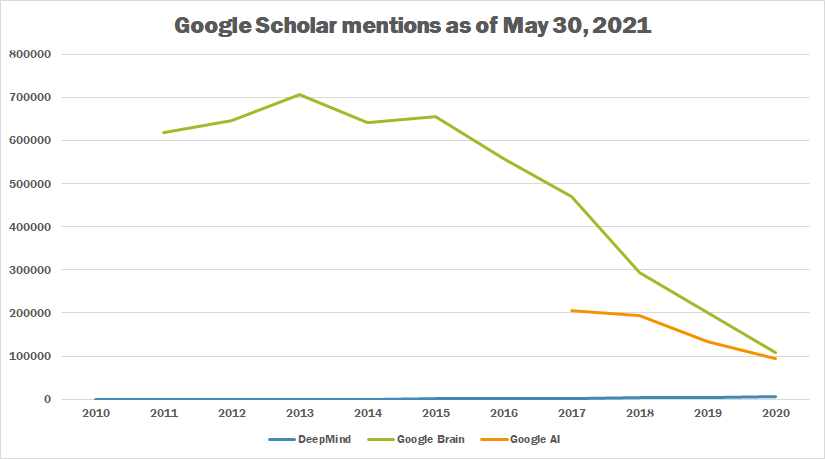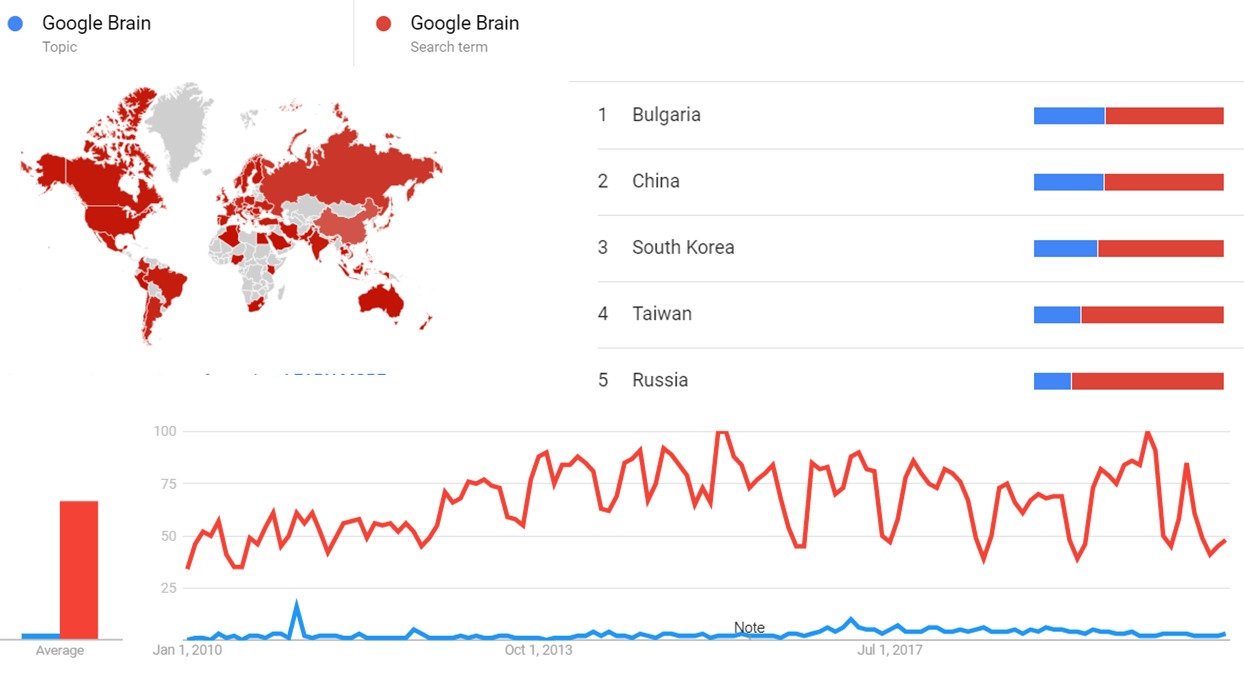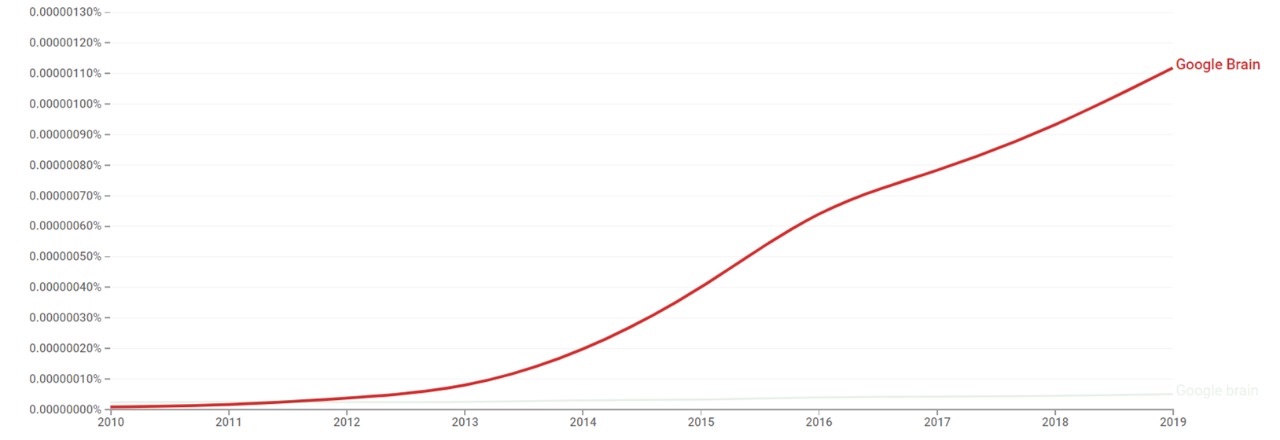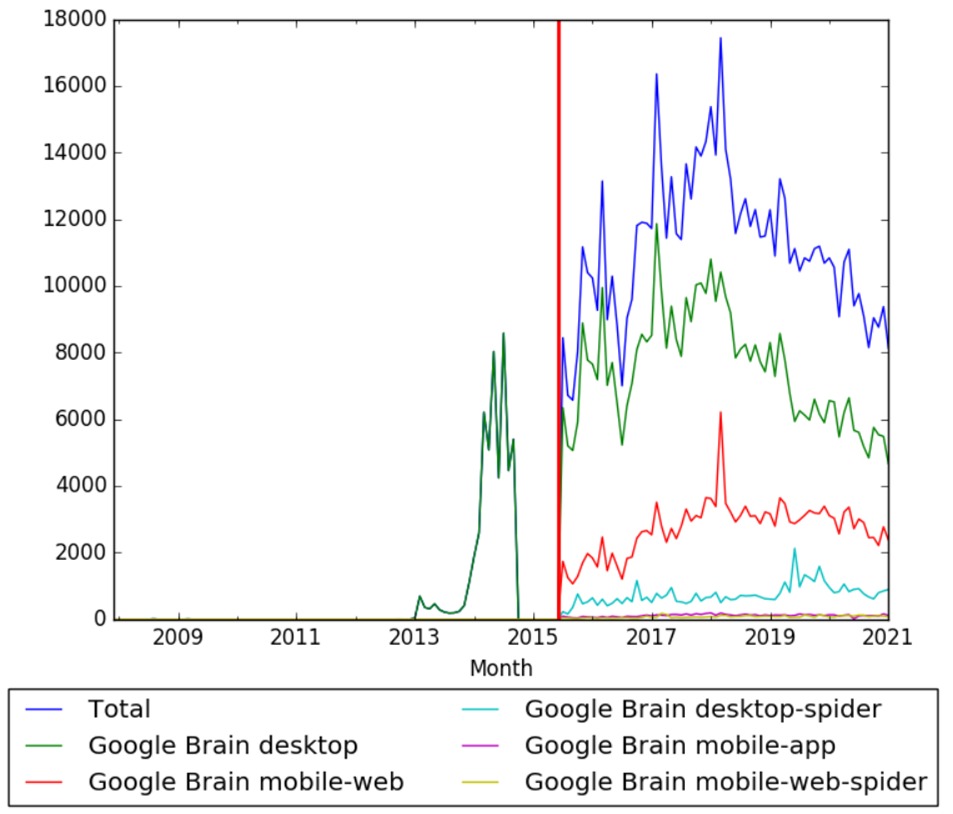Difference between revisions of "Timeline of Google Brain"
(→Visual data) |
(→Mentions on Google Scholar) |
||
| Line 44: | Line 44: | ||
|} | |} | ||
| − | [[File: | + | [[File:Deepmind gogle brain tb.png|thumb|center|700px]] |
=== Google Trends === | === Google Trends === | ||
Revision as of 14:11, 30 May 2021
This is a timeline of Google Brain.
Contents
Big picture
| Time period | Development summary | More details |
|---|
Numerical and visual data
Mentions on Google Scholar
The following table summarizes per-year mentions on Google Scholar as of May 30, 2021.
| Year | DeepMind | Google Brain | Google AI |
|---|---|---|---|
| 2010 | 97 | ||
| 2011 | 84 | 619,000 | |
| 2012 | 107 | 646,000 | |
| 2013 | 112 | 708,000 | |
| 2014 | 252 | 641,000 | |
| 2015 | 480 | 655,000 | |
| 2016 | 1,450 | 558,000 | |
| 2017 | 2,430 | 471,000 | 206,000 |
| 2018 | 3,810 | 295,000 | 195,000 |
| 2019 | 4,760 | 200,000 | 134,000 |
| 2020 | 5,570 | 108,000 | 94,900 |
Google Trends
The comparative chart below shows Google Trends data for Google Brain (Topic) and Google Brain (Search termn) from January 2010 to February 2021, when the screenshot was taken. Interest is also ranked by country and displayed on world map.[1]
Google Ngram Viewer
The chart below shows Google Ngram Viewer data for Google Brain from 2010 to 2019.[2]
Wikipedia Views
The chart below shows pageviews of the English Wikipedia article Google Brain on desktop from December 2007, and on mobile-web, desktop-spider,mobile-web-spider and mobile app, from July 2015; to January 2021.[3]
Full timeline
| Year | Month and date | Event type | Details |
|---|---|---|---|
| 2011 | Andrew Ng launches "the Deep Learning project at Google".[4] This project would eventually become Google Brain. | ||
| 2011 | early in the year | Jeff Dean runs into Andrew Ng at a Google campus microkitchen. Ng tells Dean about Project Marvin, an internal effort to experiment with neural networks. Dean begins working on the project during his "20 percent time". Soon Dean brings in Greg Corrado and Ng invites one of his graduate students, Quoc Le. Project Marvin would eventually be referred to as Google Brain.[5] | |
| 2011 | November 13 | A New York Times article from this day covering Google X mentions that Andrew Ng is at Google X.[6] | |
| 2012 | "Large Scale Distributed Deep Networks" by Jeff Dean et al. is published. The paper introduces the software framework DistBelief, a precursor to TensorFlow.[7][8] | ||
| 2012 | December | Ray Kurzweil joins Google as a director of engineering.[9] When asked whether he is trying to build an artificial "Google Brain" as part of Jeff Dean's program, Kurzweil replies that "Jeff Dean is one of my collaborators".[10] It's not clear whether he was actually part of what would become Google Brain. | |
| 2012 | June 26 | A blog post by Jeff Dean and Andrew Ng is published on the official Google blog. The post covers work done by the two at Google; in particular it announces the paper "Building High-level Features Using Large Scale Unsupervised Learning", which has been called "the cat paper". Neither the blog post nor the paper mentions a "Google Brain" (either as a project name or a team name), but this work was done by the Google Brain project.[11][5] | |
| ? | Andrew Ng leaves Google to lead Baidu's AI team.[5] | ||
| 2013 | March | Google hires Geoffrey Hinton and acquires DNNresearch Inc., the neural networks company started by Hinton and two of his graduate students, Alex Krizhevsky and Ilya Sutskever.[12] The news reporting does not mention what Hinton would be working on at Google, but presumably he joined what would become Google Brain. | |
| 2013 or 2014? | Google Brain graduates out of Google X and into "the broader research organization" (does that mean Google Research?). At this point the Google Brain team has fewer than 10 people.[5] | ||
| 2015 | June 17 | The "Inceptionism" blog post is published on the Google Research/AI blog. The post explains a method of gradually tweaking images to see what a neural network has learned, and gives examples of the resulting dream-like images.[13] (The post doesn't explicitly mention Google Brain, but the post has the "Google Brain" label.) | |
| 2015 | July 1 | The DeepDream repository is published on GitHub.[14] | |
| 2015 | October 2015 | The Google Brain Residency, a 12-month program for early-career deep learning researchers, is announced. The first group of residents would begin in June 2016.[15][16][17][18][19] | |
| 2015 | November 9 | Google open-sources TensorFlow, a machine learning library. "TensorFlow was originally a project developed by researchers and engineers working on the Google Brain Team within Google's Machine Intelligence research organization".[20][21][22] The TensorFlow preliminary white paper is also published on this day.[23] | |
| 2016 | February | Greg Corrado and Jeff Dean of Google Brain approach Macduff Hughes, the director of Google Translate. Corrado and Dean tell Hughes that Google Translate could be overhauled with a neural network-based approach to machine translation by the end of 2016.[5] | |
| 2016 | April 8 | The Google Brain team page is shared on Hacker News.[24] This is possibly the first verifiable date on which "Google Brain" is used as a team name. | |
| 2016 | April 16 | The first Internet Archive snapshot of the Google Brain team web page is from this day.[25] | |
| 2016 | June 1 | Magenta, a Google Brain project that uses machine learning to generate art and music, is announced.[26] | |
| 2016 | August 4 | The Google Brain team does an AMA ("ask me anything") on Reddit on the subreddit r/MachineLearning.[27] | |
| 2016 | September 27 | The Google Neural Machine Translation system is announced in a post on the Google AI Blog. The post is written by research scientists on the Google Brain team, and the post acknowledges the Google Brain team for contributions to the project.[28] For more information, see Google Brain § Google Translate. | |
| 2016 | October 21 | "Learning to Protect Communications with Adversarial Neural Cryptography" by Martín Abadi and David G. Andersen of Google Brain is uploaded to the arXiv. The paper trains neural networks to learn encryption and decryption.[29][30] See Google Brain § Artificial-intelligence-devised encryption system for more information. | |
| 2017 | February 2 | "Pixel Recursive Super Resolution" by Ryan Dahl, Mohammad Norouzi and Jonathon Shlens of Google Brain is uploaded to the arXiv. The paper describes a way to use neural networks to enhance pixelated input images into realistic higher-resolution images.[31][32][33][34] For more information, see Google Brain § Image enhancement. | |
| 2017 | February 15 | TensorFlow 1.0.0 is released.[35] (It's not clear that the Google Brain team still maintains TensorFlow, so this event may not belong on the timeline.) | |
| 2017 | September 9 | The Google Brain team does its second AMA ("ask me anything") on Reddit on the subreddit r/MachineLearning.[36] | |
| 2018 | January | The Google Brain Residency program is renamed to the Google AI Residency program as a result of broadening the research groups participating in the program.[37] |
Meta information on the timeline
How the timeline was built
The initial version of the timeline was written by Issa Rice.
Funding information for this timeline is available.
Feedback and comments
Feedback for the timeline can be provided at the following places:
- FIXME
What the timeline is still missing
- https://en.wikipedia.org/wiki/Google_Neural_Machine_Translation#History
- I can't tell if https://en.wikipedia.org/wiki/RankBrain has anything to do with Google Brain.
- be clearer about the connection between google x and google brain
Timeline update strategy
See also
External links
References
- ↑ "Google Brain". Google Trends. Retrieved 23 February 2021.
- ↑ "Google Brain". books.google.com. Retrieved 23 February 2021.
- ↑ "Google Brain". wikipediaviews.org. Retrieved 24 February 2021.
- ↑ Daniela Hernandez (May 7, 2013). "The Man Behind the Google Brain: Andrew Ng and the Quest for the New AI". Wired Enterprise. Archived from the original on June 1, 2013. Retrieved May 12, 2018.
- ↑ 5.0 5.1 5.2 5.3 5.4 Gideon Lewis-Kraus. "The Great A.I. Awakening". The New York Times. Retrieved May 17, 2018.
- ↑ Miller, Claire Cain; Bilton, Nick (November 13, 2011). "At Google X, a Top-Secret Lab Dreaming Up the Future". The New York Times. Retrieved May 12, 2018.
- ↑ Jeffrey Dean; et al. (2012). "Large Scale Distributed Deep Networks" (PDF).
- ↑ "Large Scale Distributed Deep Networks". Retrieved June 13, 2018.
- ↑ Taylor, Colleen (December 15, 2012). "Ray Kurzweil Joins Google In Full-Time Engineering Director Role; Will Focus On Machine Learning, Language Processing". TechCrunch. Retrieved May 13, 2018.
- ↑ Levy, Steven (April 25, 2013). "How Ray Kurzweil Will Help Google Make the Ultimate AI Brain". WIRED. Retrieved May 13, 2018.
- ↑ Dean, Jeff; Ng, Andrew. "Using large-scale brain simulations for machine learning and A.I.". Official Google Blog. Retrieved May 12, 2018.
- ↑ U of T Media (March 12, 2013). "Media Room & Blue Book – University of Toronto". Retrieved May 13, 2018.
- ↑ "Inceptionism: Going Deeper into Neural Networks". Google AI Blog. Retrieved June 13, 2018.
- ↑ "google/deepdream". GitHub. Retrieved June 13, 2018.
- ↑ Dean, Jeff; Phillips, Leslie (January 5, 2017). "Google Brain Residency Program - 7 months in and looking ahead". Google Research Blog. Archived from the original on January 6, 2017. Retrieved June 13, 2018.
In October 2015 we launched the Google Brain Residency, a 12-month program focused on jumpstarting a career for those interested in machine learning and deep learning research. This program is an opportunity to get hands on experience using the state-of-the-art infrastructure available at Google, and offers the chance to work alongside top researchers within the Google Brain team.
- ↑ "Shobeir Fakhraei on Twitter". Twitter. October 22, 2015. Retrieved June 13, 2018.
Jeff Dean announced Google Brain Residency Program @googleresearch at #baylearn
- ↑ D'Onfro, Jillian (October 22, 2015). "Google is 're-thinking' all of its products to include machine learning". Business Insider. Retrieved June 13, 2018.
As Google was reporting earnings, Google's head of research Jeff Dean announced a new Brain Residency Program. The 12-month role will be similar to a Master's or PhD program in deep learning, a branch of machine learning that aims to mimic the brain.
- ↑ doomie (October 23, 2015). "Google Brain residency program • r/MachineLearning". reddit. Retrieved June 13, 2018.
- ↑ keveman (October 23, 2015). "Google Brain Residency Program". Hacker News. Retrieved June 13, 2018.
- ↑ Perez, Sarah (November 10, 2015). "Google Open-Sources The Machine Learning Tech Behind Google Photos Search, Smart Reply And More". TechCrunch. Retrieved May 17, 2018.
- ↑ Vanhoucke, Vincent. "Very proud to be open-sourcing TensorFlow, Google's newest Deep Learning fram...". Retrieved May 17, 2018.
TensorFlow is what we use every day in the Google Brain team, and while it's still very early days and there are a ton of rough edges to be ironed out, I'm excited about the opportunity to build a community of researchers, developers and infrastructure providers around it.
- ↑ "tensorflow/tensorflow". GitHub. Retrieved May 18, 2018.
TensorFlow was originally developed by researchers and engineers working on the Google Brain team within Google's Machine Intelligence Research organization for the purposes of conducting machine learning and deep neural networks research.
- ↑ Abadi; et al. "TensorFlow: Large-Scale Machine Learning on Heterogeneous Distributed Systems" (PDF). Retrieved May 17, 2018.
- ↑ "Google Brain Team". Hacker News. Retrieved May 12, 2018.
- ↑ "Research at Google". Archived from the original on April 16, 2016. Retrieved May 12, 2018.
- ↑ Eck, Douglas (June 1, 2016). "Welcome to Magenta!". Magenta. Retrieved May 17, 2018.
- ↑ "AMA: We are the Google Brain team. We'd love to answer your questions about machine learning. • r/MachineLearning". reddit. Retrieved May 12, 2018.
- ↑ Le, Quoc V.; Schuster, Mike (September 27, 2016). "A Neural Network for Machine Translation, at Production Scale". Google AI Blog. Retrieved May 13, 2018.
- ↑ "[1610.06918] Learning to Protect Communications with Adversarial Neural Cryptography". Retrieved June 13, 2018.
- ↑ Anthony, Sebastian (October 28, 2016). "Google teaches "AIs" to invent their own crypto and avoid eavesdropping". Ars Technica. Retrieved June 13, 2018.
- ↑ "[1702.00783] Pixel Recursive Super Resolution". Retrieved June 13, 2018.
- ↑ Anthony, Sebastian (February 7, 2017). "Google Brain super-resolution image tech makes "zoom, enhance!" real". Ars Technica. Retrieved June 13, 2018.
- ↑ Hollister, Sean (February 7, 2017). "Google just made 'zoom and enhance' a reality – kinda". CNET. Retrieved June 13, 2018.
- ↑ Fingas, Jon (February 7, 2017). "Google uses AI to sharpen low-res images". Engadget. Retrieved June 13, 2018.
- ↑ Feng, Yifei (February 15, 2017). "TensorFlow 1.0.0". GitHub. Retrieved June 13, 2018.
- ↑ "We are the Google Brain team. We'd love to answer your questions (again) • r/MachineLearning". reddit. Retrieved May 12, 2018.
- ↑ Dean, Jeff (January 12, 2018). "The Google Brain Team — Looking Back on 2017 (Part 2 of 2)". Google AI Blog. Retrieved June 13, 2018.
We've now broadened the program to include many other research groups across Google and renamed it the Google AI Residency program (the application deadline for this year's program has just passed; look for information about next year's program at g.co/airesidency/apply).



